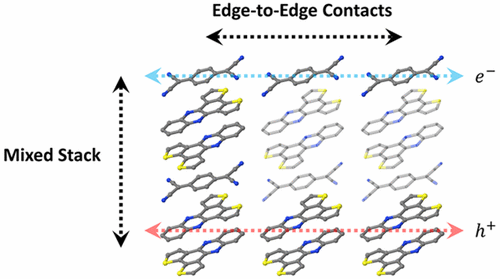当前位置:
X-MOL 学术
›
J. Phys. Chem. Lett.
›
论文详情
Our official English website, www.x-mol.net, welcomes your
feedback! (Note: you will need to create a separate account there.)
Unusual Electronic Structure of the Donor–Acceptor Cocrystal Formed by Dithieno[3,2-a:2′,3′-c]phenazine and 7,7,8,8-Tetracyanoquinodimethane
The Journal of Physical Chemistry Letters ( IF 4.8 ) Pub Date : 2017-09-07 00:00:00 , DOI: 10.1021/acs.jpclett.7b01816 Qianxiang Ai 1 , Yulia A. Getmanenko 2 , Karol Jarolimek 1 , Raúl Castañeda 2 , Tatiana V. Timofeeva 2 , Chad Risko 1
The Journal of Physical Chemistry Letters ( IF 4.8 ) Pub Date : 2017-09-07 00:00:00 , DOI: 10.1021/acs.jpclett.7b01816 Qianxiang Ai 1 , Yulia A. Getmanenko 2 , Karol Jarolimek 1 , Raúl Castañeda 2 , Tatiana V. Timofeeva 2 , Chad Risko 1
Affiliation

|
Mixed cocrystals derived from electron-rich donor (D) and electron-deficient acceptor (A) molecules showcase electronic, optical, and magnetic properties of interest for a wide range of applications. We explore the structural and electronic properties of a cocrystal synthesized from dithieno[3,2-a:2′,3′-c]phenazine (DTPhz) and 7,7,8,8-tetracyanoquinodimethane (TCNQ), which has a mixed-stack packing arrangement of the (π-electronic) face-to-face stacks in a 2:1 D:A stoichiometry. Density functional theory investigations reveal that the primary electronic characteristics of the cocrystal are not determined by electronic interactions along the face-to-face stacks, but rather they are characterized by stronger electronic interactions orthogonal to these stacks that follow the edge-to-edge donor–donor or acceptor–acceptor contacts. These distinctive electronic characteristics portend semiconducting properties that are unusual for semiconducting mixed cocrystals and suggest further potential to design organic semiconductors with orthogonal transport characteristics for different charge carriers.
中文翻译:

Dithieno [3,2- a:2',3'- c ]吩嗪和7,7,8,8-四氮杂萘醌甲烷形成的供体-受体共晶体的异常电子结构
衍生自富电子供体(D)和电子缺乏受体(A)分子的混合共晶体展现出广泛应用中感兴趣的电子,光学和磁性特性。我们探索了由双硫杂诺[3,2- a:2',3'- c合成的共晶体的结构和电子性质]吩嗪(DTPhz)和7,7,8,8-四氰基喹二甲烷(TCNQ),其具有以2:1 D:A化学计量比的(π-电子)面对面堆的混合堆垛排列方式。密度泛函理论研究表明,共晶的主要电子特性不是由沿面对面堆叠的电子相互作用决定的,而是由与沿边对边供体的这些堆叠正交的更强的电子相互作用来表征的。 –供体或受体–受体接触。这些独特的电子特性预示着半导体混合共晶体不常见的半导体特性,并为设计具有不同电荷载流子正交传输特性的有机半导体提供了进一步的潜力。
更新日期:2017-09-07
中文翻译:

Dithieno [3,2- a:2',3'- c ]吩嗪和7,7,8,8-四氮杂萘醌甲烷形成的供体-受体共晶体的异常电子结构
衍生自富电子供体(D)和电子缺乏受体(A)分子的混合共晶体展现出广泛应用中感兴趣的电子,光学和磁性特性。我们探索了由双硫杂诺[3,2- a:2',3'- c合成的共晶体的结构和电子性质]吩嗪(DTPhz)和7,7,8,8-四氰基喹二甲烷(TCNQ),其具有以2:1 D:A化学计量比的(π-电子)面对面堆的混合堆垛排列方式。密度泛函理论研究表明,共晶的主要电子特性不是由沿面对面堆叠的电子相互作用决定的,而是由与沿边对边供体的这些堆叠正交的更强的电子相互作用来表征的。 –供体或受体–受体接触。这些独特的电子特性预示着半导体混合共晶体不常见的半导体特性,并为设计具有不同电荷载流子正交传输特性的有机半导体提供了进一步的潜力。





















































 京公网安备 11010802027423号
京公网安备 11010802027423号